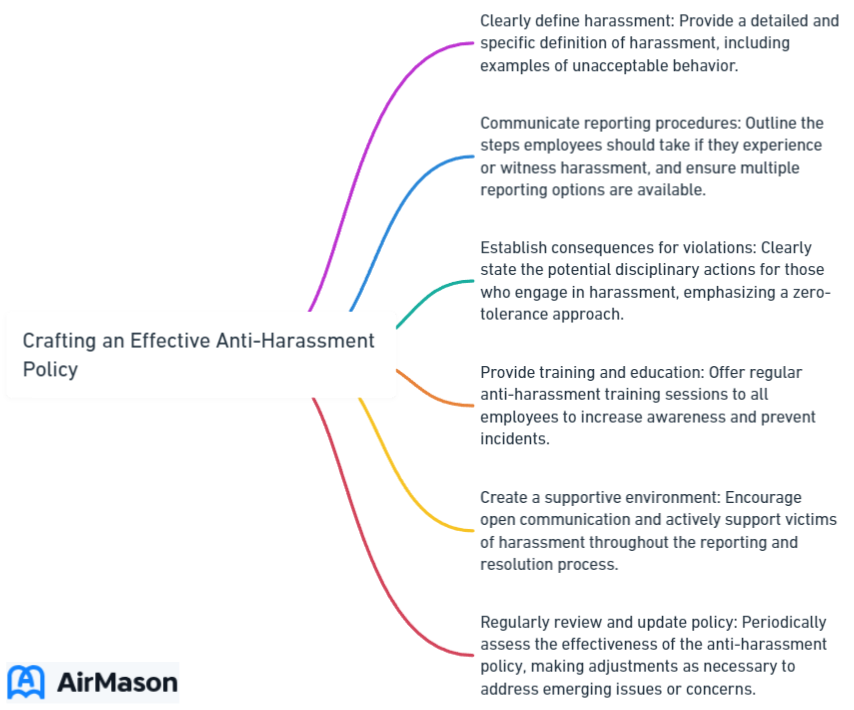
In a world where workplace dynamics are constantly evolving, the importance of a comprehensive and effective anti-harassment policy cannot be overstated. Not only does it protect employees from unwanted behavior, but it also fosters a respectful work environment and protects the employer legally. Are you aware of the crucial components that constitute a robust anti-harassment policy and how to enforce it effectively?
Let’s explore the key elements of crafting an anti-harassment policy, addressing remote work and online harassment, implementing and enforcing the policy, creating a positive workplace culture, and ensuring legal compliance. By the end of this blog post, you will have the knowledge to develop a policy that safeguards your employees and your organization.
Key Takeaways
- Creating an effective anti-harassment policy is essential for protecting employers from legal risks and maintaining a respectful workplace.
- Key components of an anti-harassment policy include clear definitions, reporting procedures, confidentiality measures and protection from retaliation.
- Employers should emphasize training, investigation documentation and disciplinary measures to ensure compliance with relevant laws when implementing the policy.
Understanding the Importance of an Anti-Harassment Policy
An effective anti-harassment policy serves as a powerful tool to prevent unwanted behavior, nurture a respectful work environment, and secure legal protection for the employer. In fact, it is vital for compliance with federal laws. Such a policy applies to all personnel, regardless of whether the accused wrongdoer is an employee. Employees who experience harassment have the right to seek legal redress from the relevant governmental bodies at any time.
By having a comprehensive anti-harassment policy, employers can:
- Deter inappropriate behavior
- Cultivate a respectful work atmosphere
- Ensure employee well-being
- Build a strong and cohesive team
- Safeguard the employer from a legal standpoint by ensuring compliance with federal and local laws.

Sexual Harassment Policy
A sexual harassment policy is a crucial component of any organization, establishing clear guidelines and expectations regarding appropriate conduct in the workplace. This policy outlines unacceptable behaviors related to sexual harassment, ensuring that all employees understand the organization’s commitment to maintaining a safe and respectful environment. It provides definitions of sexual harassment, examples of such behavior, reporting mechanisms, and the consequences for violations. The purpose of a sexual harassment policy is to promote a culture of respect, equality, and professionalism within the workplace, fostering an atmosphere where all individuals are treated with dignity and fairness. By having a comprehensive sexual harassment policy in place, organizations demonstrate their dedication to preventing harassment and creating a supportive workplace for all.
Key Components of an Anti-Harassment Policy

An effective anti-harassment policy should encompass clear definitions of harassment and discrimination, detailed reporting procedures, and guarantees of confidentiality and protection from retaliation.
We’ll now explore these components to understand their contribution to a robust policy.
Defining Harassment and Discrimination
A comprehensive definition of harassment and discrimination helps employees recognize unacceptable behaviors in the workplace. Harassment is behaviour that is done over an extended period of time and with no invitation. It targets people for their gender, ethnicity, age or disability making it unlawful according to existing laws. One specific form of harassment is sexual harassment, which involves unwelcome sexual advances, unwanted sexual advances, unwelcome physical contact of a sexual nature, or unwelcome verbal or physical conduct of a sexual nature. Recognizing and addressing harassing behavior is crucial for maintaining a safe and inclusive work environment.
Examples of prohibited conduct include such conduct as:
- Making offensive or degrading remarks, verbal abuse, or other hostile behavior
- Making racial slurs, derogatory remarks about a person’s accent, or displaying racially offensive symbols
- Making unwelcome or inappropriate physical contact, comments, questions, advances, jokes, or demands, including requests for sexual favors
- Physical assault or stalking
A clear understanding of these definitions and examples helps employees recognize and report prohibited behavior.
Reporting Procedures and Channels
Well-defined reporting procedures and diverse channels for reporting harassment remain integral parts of an anti-harassment policy. Employees should report any witnessed cases of bullying or harassing to their supervisor. If their direct supervisor is the one displaying such behaviour, they should make a report to another supervisor or human resources instead.
The company should be committed to investigating reports of inconsistent conduct in a timely and comprehensive manner. Furthermore, to ensure the protection of those who have lodged a complaint of harassment, the company should take whatever interim steps are necessary to prevent any further occurrences of bullying, harassment, or retaliation during the investigation.
Confidentiality and Protection from Retaliation
Maintaining confidentiality is paramount in addressing harassment allegations, as it allows employees to report incidents without fear of repercussions. All reasonable measures should be taken to ensure that the situation is divulged only to those with a need to know, and that complaints of unlawful harassment are handled as discreetly and confidentially as possible under the circumstances.
Strictly prohibited is any retaliatory treatment of an employee for reporting discrimination, harassment, or other forbidden behavior. Additionally, no retaliatory action may be taken on the employee for cooperating in a harassment investigation. Employees who come across any conduct they feel is retaliatory should report it to the relevant authorities immediately. This can be done by either informing a supervisor, Human Resources representative or Employee Relations, or through the Global Ethics Hotline.
Discrimination and Harassment in the Workplace
Discrimination and harassment in the workplace are deeply concerning issues that encompass various forms of unfair treatment based on attributes such as race, gender, age, religion, sexual orientation, and more. This toxic behavior can manifest in subtle or overt ways, affecting employees’ well-being, productivity, and overall job satisfaction. Addressing discrimination and harassment requires a comprehensive approach, including educating employees and management about acceptable behavior, implementing clear policies, fostering an inclusive and respectful workplace culture, and providing mechanisms for reporting incidents confidentially. Employers must be proactive in creating an environment where every employee feels safe, respected, and free from discrimination and harassment, ultimately fostering a more productive and harmonious workplace.
Addressing Remote Work and Online Harassment

Given today’s work environment, the need to address remote work and online harassment has grown, especially as personal and professional boundaries blur. A Project Include report clearly states that 45% of employees have spotted harassment behavior in online chat conversations. Additionally, the same report further reveals that 41% of employees have encountered it in email and video meetings..
The most frequent types of online harassment in remote work settings include:
- Cyberbullying
- Discriminatory comments
- Cyberstalking
- Invasion of privacy
- Unsolicited sexually explicit content
The blurring of the line between home and professional lives when working remotely could lead to some individuals exhibiting careless or unacceptable conduct, such as disregarding others’ gender identity, while communicating digitally.
Incorporating remote work and online harassment issues in your anti-harassment policy will help ensure the safety and support of your employees, even in remote working situations.
Implementing and Enforcing the Anti-Harassment Policy

Effective implementation and enforcement of an anti-harassment policy necessitates a focus on training and awareness, meticulous investigation and documentation of harassment complaints, and suitable disciplinary measures.
We’ll dissect each of these steps to understand them better.
Training and Awareness

Frequent training and awareness programs help ensure that employees fully understand the policy and the procedures for reporting incidents. These programs should be conducted at least annually, to keep employees up-to-date with the policy and any changes that may occur.
Training sessions should cover the following topics:
- Definitions and examples of harassment and discrimination
- Reporting procedures and channels
- The importance of confidentiality
- The company’s commitment to preventing retaliation
Employers can cultivate a work environment where employees feel at ease reporting incidents and are well-versed in their rights and responsibilities by regularly providing training and enhancing awareness about the anti-harassment policy.
Investigating and Documenting Complaints
In order to resolve issues and prevent future occurrences, it is crucial to immediately report complaints, promptly investigate them, and document them thoroughly. Supervisors and managers are obligated to investigate the conduct and take appropriate action, or to report any suspected harassment to the designated authority. Employers should take swift action each time an employee alleges harassment and follow the protocol for every allegation, irrespective of the circumstances.
It is imperative to follow up after the completion of a harassment investigation to ensure that the issue has been entirely settled. By conducting comprehensive investigations and maintaining detailed documentation of complaints, employers can effectively address harassment allegations and create a safer work environment for all employees.
Disciplinary Measures and Corrective Actions
The disciplinary measures taken should align with the severity of the misconduct and be consistently applied throughout the organization. A minimum of a verbal or written reprimand should be issued, with advice on how to prevent future admonishments. Additional steps that can be taken include:
- Job relocation
- Obligatory sensitivity instruction
- Suspension
- Demotion
- Dismissal
Employers should periodically assess whether employees who have faced disciplinary action are adhering to the anti-harassment policy and have fulfilled any corrective action that may have been mandated. By implementing appropriate disciplinary measures and corrective actions, employers can effectively deter harassment and maintain a respectful work environment.
Discriminatory Conduct
Discriminatory conduct refers to any action, behavior, or treatment that unfairly singles out and disadvantages individuals or groups based on certain characteristics such as race, gender, ethnicity, religion, disability, sexual orientation, or age. This kind of conduct can manifest in various forms, including but not limited to, unequal treatment, prejudice, bias, harassment, or exclusion. It violates fundamental human rights and undermines the principles of equality and fairness in society. Combating discriminatory conduct requires not only legal frameworks and policies but also a collective effort to promote awareness, educate communities, and foster inclusivity. By challenging discriminatory conduct and promoting tolerance and understanding, we can work towards a more just and equitable world for all.
Creating a Positive Workplace Culture
A positive workplace culture, supported by leadership and HR, encourages employees to report harassment and fosters an environment of respect and acceptance. To foster a positive workplace culture, employers can:
- Prioritize onboarding and training
- Create a comfortable work environment
- Conduct regular check-ins
- Encourage team collaboration
- Set clear departmental goals
- Promote the organization’s goals
- Promote diversity and inclusivity
Leadership and HR significantly contribute to fostering a positive workplace culture by encouraging the reporting of harassment and nurturing an environment of respect and acceptance. By creating a supportive environment, employees will be more likely to report incidents of harassment, leading to a safer and more inclusive workplace for all.
Legal Considerations and Compliance

When drafting and implementing an anti-harassment policy, it is vital to consider legal aspects and ensure compliance with relevant laws and regulations. Employers may need to seek legal advice to ensure their policy is effective and compliant with applicable laws.
In the US, employers with six or more employees are mandated to have an anti-harassment policy addressing harassment based on protected characteristics such as:
- race
- color
- religion
- sex
- sexual orientation
- national origin
- disability
- marital status
Different countries or states may have specific requirements for anti-harassment policies, emphasizing the need to familiarize yourself with the laws in your jurisdiction. By ensuring legal compliance and seeking legal counsel when necessary, employers can create an anti-harassment policy that effectively protects their employees and organization.
Summary
In conclusion, crafting an effective anti-harassment policy involves understanding its importance, identifying key components, addressing remote work and online harassment, implementing and enforcing the policy, creating a positive workplace culture, and ensuring legal compliance. By carefully considering each of these aspects and taking appropriate action, employers can create a safe and inclusive work environment where employees feel respected and protected.
As we continue to navigate the complexities of modern workplaces, let us commit to fostering a culture of respect, inclusivity, and open communication. Together, we can make a difference and create a better workplace for everyone.
Frequently Asked Questions
What is an example of an anti-harassment policy in the workplace?
The Company prohibits any forms of intimidation, humiliation or discrimination based on age, sexual orientation, ethnicity, racial, religion or disability. Violations of this policy may result in disciplinary action, up to and including termination.
What does the EEOC recommend anti-harassment policy include?
The EEOC recommends anti-harassment policies include a clear definition of prohibited conduct, an obligation for supervisors and managers to report allegations of harassment, anonymous reporting through platforms like hotlines and websites, resources for responding promptly and effectively to complaints, and a prohibition on workplace harassment due to race, color, national origin, sex, religion, disability, age, or genetic information.
What are three purposes of a company’s anti-harassment policy?
A company’s anti-harassment policy serves to prevent incidents of harassment, create an environment where employees feel safe and valued, and provide guidance on reporting and addressing allegations of harassment.
What is the UPS professional conduct and anti-harassment policy?
UPS Professional Conduct and Anti-Harassment Policy prohibits unprofessional and disrespectful conduct and requires that employees treat each other with courtesy, consideration, and professionalism. It also prohibits subjecting employees or applicants to harassment, intimidation, threats, coercion, or discrimination, maintaining a work environment that respects the rights of all employees and is free from any hostile or offensive behavior.
What are some examples of harassment and discrimination?
Harassment and discrimination can take many forms, such as making offensive or derogatory remarks, verbal abuse, racial slurs, and unwelcome physical contact. It can even escalate to physical assault or stalking.